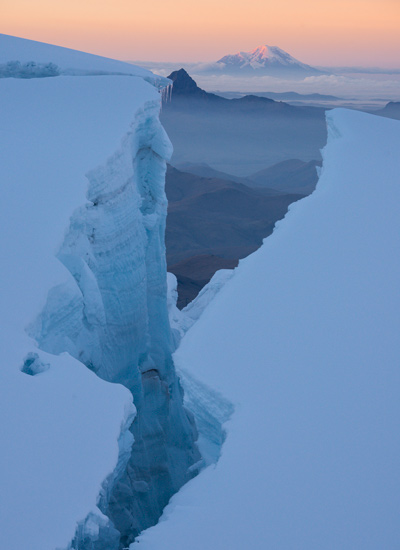
TJ David reshapes turns on Ecuador’s Cotopaxi (19,347 ft.) [Photo] Adam Moszynski
Before Ecuador launched their guiding legislation, they had already taken measures to organize their guides on a national level. In 1990, Ecuador established the Asociación Ecuatorania de Guías de Montaña (ASEGUIM), their national mountain guides association, which gained official legal status in 1993. Similarly in Peru, the Casa de Guías, or House of Guides, has served as a national guiding organization since the 1980s.
“It’s a huge organization. You go in, tell them what you want to do, and they get you a guide, cooks and porters,” TJ David says of the Peruvian nonprofit. “It’s pretty regulated.” Over the past two years, David has traveled to both Peru and Ecuador as part of baselayer company Corbeaux Clothing’s campaign to donate apparel to guiding associations. In both locations, David’s hired guides for climbing and skiing missions.

Sunrise on Chimborazo (20,564 ft.), Ecuador’s highest peak, from the flanks of Antisana (18,714 ft.). [Photo] Steve Ogle
That emphasis on certification, and on overall avalanche education, is relatively new for much of South America, says Greg Shaffran, an avalanche instructor and guide for Aspen Expeditions who has spent the past three summers in Chile and, last season, began teaching avalanche courses in Ushuaia, Farellones, Laguna Del Maule and Chillán. “I can attest to how new the theme of avalanche education is,” he says. “The first formal avalanche classes weren’t taught here until 2011, and this year is the first time they are hosting a professional level course [AIARE Level 3] here in South America.”
Shaffran attributes the rising interest to a few factors, including new gear that makes backcountry access easier and more enjoyable; a stagnation in resort development, lifts and grooming; and an abundance of inspiring terrain. But despite a growing population looking to head off piste, Shaffran notes that there is still some missing groundwork for managing risk. “There are no avalanche centers to issue bulletins and compile and share public observations,” he says. “And there are no—or very few and not publicly accessible—weather stations. These combined facts make it very hard for people to get an accurate picture of what is happening with the snow over terrain.”
While it may be some time before those public bulletins are available, the South American Beacon Project, founded in 2010 by Alex Taran, is doing its part to increase avalanche knowledge and awareness. The SABP is a two-part scheme; firstly, they look to supply rescue organizations and personnel with up-to-date avalanche and rescue equipment, and secondly, they offer training to those they supply equipment to, as well as to the general public.
“We want people talking about things that go on during the winter, because they never were before,” says Taran. “Before, when there was an accident, they wanted someone to blame, so no one would talk about it. Now, people are starting to talk about avalanches, realizing that it is an opportunity to learn and share this knowledge and experience with other people.”
Chilean skiers are also taking advantage of apps and websites that cater to sharing information, Shaffran has found. “People are sharing observations via WhatsApp and Facebook groups, and I can see some informal bulletins starting to pop up spontaneously and naturally,” he says. “I also think many students here have a very good grasp of weather, what effects it has on the snow over terrain and an eagerness to learn more.”
Given the progress and established legislation for mountain safety, Shaffran is hopeful for the future of South America’s avalanche education. “One of the things I’m particularly excited about, being here at this time, is that I get to see new instructors, guide services and future forecasters starting to cut their teeth,” he says. “This is an exciting time in South American snow safety—at times it feels like the Wild, Wild West.”











Related posts:
Backstory: Hot, Flat and Snowy
Ryan Koupal’s 40 Tribes Backcountry offers Asia’s most exotic yurt trips
Mountain Skills: Planning a trip to an offbeat location requires more than Google
The Seventh Sojourn: It’s impermissible to ski on Kilimanjaro. Will it soon be impossible?